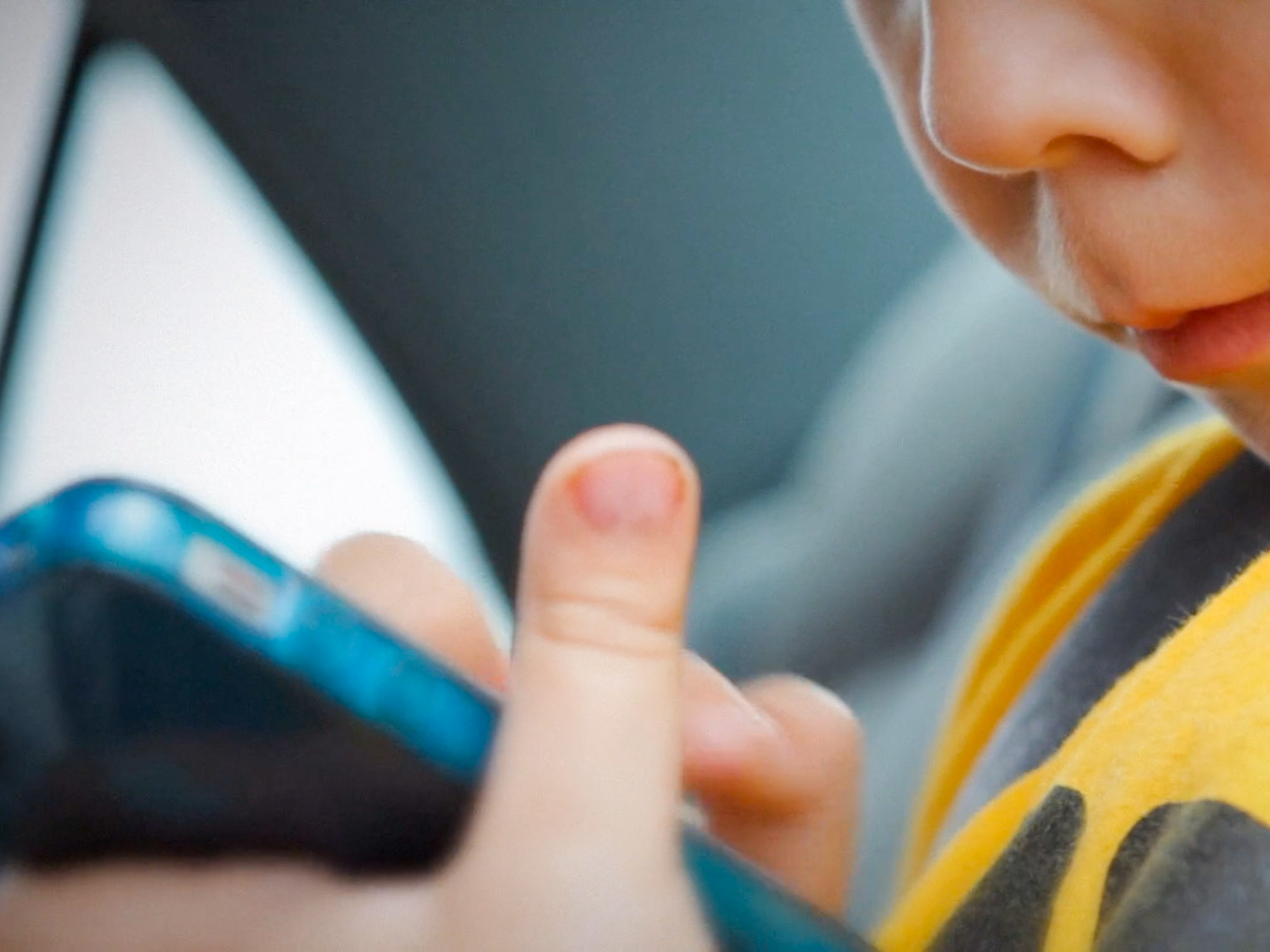Spaces and time are dwindling in which children can have sensory, natural experiences and discover and play at their own pace. Childhood has never been as unchildlike as it is today. The working world of adults outshines everything else. With the advent of the internet, digital work and social media, adults often don’t know how to take time for themselves and their children. How does education for autonomy succeed in the digital age? Henning Kullak-Ublick introduces ways and co-produced a documentary on the subject: ‹#KidsOnTech›.
Franka Henn How did the film project come about and what synergies did the production generate?
Henning Kullak-Ublick We had already made four films for Waldorf100 with the director Paul Zehrer. ‹#KidsOnTech› is the last in this series. Our intention was to present media and childhood in a way that parents and, of course, teachers in schools and kindergartens could relate to. To achieve this, the topic must reach people’s minds without moralistic finger-pointing. Paul Zehrer is an award-winning documentary maker who came to my attention because of his film ‘ Preparing for Life ‘ about the Waldorf School in Silicon Valley. This was triggered by a front-page report in the New York Times explaining why Silicon Valley’s ruling elite are sending their children to Waldorf schools, which use digital media much later than U.S. schools typically do. The article was the top-read article in the New York Times for three months. Paul’s filmmaking style inspired me because he can tell good stories about complex subjects – that’s an American virtue.
I met him in 2017 in San Francisco and the chemistry was immediately there – that resulted in five films. ‹#KidsOnTech› was supposed to be ready in 2019 for the anniversary festival in Berlin, but the film was just too complex. In retrospect, that was a good thing, because due to the Coronavirus pandemic, we had to overturn everything and start from scratch anyway: You can’t make a film about media the way you did before, because all of our experiences reach much further than before. Therefore, the production took two additional years.
FH How did you come up with the topic?
HKU In 2012, I initiated the working group ‘Media Literacy and Waldorf Education’ in the Association of Independent Waldorf Schools, to which I invited various people with very different areas of expertise, all of whom were connected to Waldorf education. In 2014, this working group initially produced the brochure “Struwwelpeter 2.0”, which was followed by a second part for parents and currently the brochure< Media education at Waldorf schools> which makes very specific proposals for schools. We’ve broken that down into curriculum suggestions that range from early childhood education to high school graduation.
Three steps in media education
FH What does Waldorf media education mean in terms of content?
HKU The Waldorf idea in particular is that indirect media education must first create a strong basis for direct media education. What do children need constitutionally, in terms of developmental psychology and for their incarnation process in preparation for the media world? How do real-life encounters with the world prepare for this? This can be transferred to an analog approach to media and only then does it move on to the digital aspect. The path thus leads from the real via the analog to the digital, whereby the first two are not replaced, of course, but supplemented. This holistic approach, to the development of which Edwin Hübner contributed significantly in its pedagogical-anthropological foundations and teacher pioneers such as Franz Glaw in its practical implementation, is undoubtedly one of the most practical concepts that exist today. I firmly believe that media education belongs in every school, because children are growing into a world increasingly organized by algorithms. We have to prepare them for this, and we have to do it in such a way that they can master it confidently and are not controlled by it. There is as little to be gained by demonizing it as by glorifying it.
FH In the film, neuroscientist Manfred Spitzer explains that the connections in the brain always change depending on how we use the brain. In the sense that we don’t ‘use’ the brain, but we do something, and our brain registers this and builds synaptic connections that mirror our experiences in the world. Children’s brains are literally on fire because they learn so rapidly. They are active all the time to be able to find their way in this world, and thus build a representative internal image of the world. What happens to children if they are regularly sitting in front of a digital medium instead of being active in the world?


HKU I think it helps to realize that there is hardly anything more frontal than sitting in front of a screen. This is, the younger the children are, just too passive. Of course, you can move your fingers, move the mouse around and seemingly do things with it, but often you only react. But the children actually have ready-made products in front of them, which they can only influence within the framework of the pre-programmed options. The body, movement, perception by discovering things, aesthetic perception and the imagination are largely left out or are externally controlled. This is the opposite of what children need to learn and develop. When we interviewed Remo Largo for the film, he responded to your question by saying that it’s not so much his concern what happens to the children when they sit in front of the devices; it’s what the children miss when they sit in front of them that worries him.
The crucial point is that children discover themselves by engaging with the world haptically, with their senses and through movement, and by establishing a real relationship with it. It’s about them having the experience: I can do something with my body, with my will. I can learn about the world, about my feelings when I encounter others through them, and I can even understand what I experience. Then they have the tools to use digital media as well. If children sit in front of screens too early and too much, they do not make these experiences actively because they only take in ready-made images, ready-made judgments, ready-made associations.
If they can follow their natural path from doing to feeling to recognizing, technology does them no harm at all. The question is not whether technology is good or bad, but what skills we need to use it sensibly. Today, however, this has become an existential question for humanity, as can be seen in the decline of our discourse culture through social media.
The question is not whether technology is good or bad, but what skills we need to use it sensibly. Today, this is an existential question.
Wanting to understand the whole world
FH You say that children are these bundles of activity. They do not come into the world with an educated mind. But I have to learn to think logically and rationally over time. Paula Bleckmann also says in the film that children are simply not adults – adults tend to forget that children experience, feel, perceive differently than they do. But if children come into the world with such a thirst for action, if they want to go out, discover, taste, smell, touch, experience everything, why are they attracted to screens in the first place? There is nothing to do or to experience with your senses. You might think that only adults are capable of doing something so boring?
HKU That is really an intriguing question that I can only partially answer. Certainly, the interest is related to the fact that movement attracts our attention. The limbic system always responds to movement. The media world works through the power of movement. It is the same in adults, it is the same in children and, by the way, it is the same in reptiles. It stimulates a layer of our consciousness that is below our waking consciousness. Second, humans yearn for images. We live from images and we tell each other things in images. It is often images that can explain the world to us, as in fairy tales or myths.
When you tell children a fairy tale, they create these images internally. They thereby use their imagination actively. They are experiencing every scene as they build them up inwardly. Thisis like a picture meditation. Ready-made images from outside eliminate the need for such efforts. Of course, this is tempting – for adults as well as for children. Children don’t judge what they see, they see what moves and those are interesting images. Children basically want to absorb everything that is in their environment and accept it as it is. They do not cognitively set themselves apart from it, but connect with it.
Another important aspect of why children seek out media lies in their role models. When they are lying in their cot and realize that mom or dad are always staring at this thing, it also becomes incredibly important to them. They learn: this is really important in life. Moreover, it is a perfectly healthy need for children to deal with the time they live in. Whether we adults think it’s good or bad, makes no difference at first for this willingness to learn about the world as it is. But it should matter to us adults.
Our generations have been overwhelmed by the continuing pace of technological development, and in proportion, we are learning very slowly how to deal with it. Our learning process is slower than the pace at which children are confronted with it, but that in no way means that we are powerless. I think that Waldorf education in particular has the best prerequisites to deal with it well, but we also have to rediscover it in many areas and be ready to change.


From excessive demands into creative practice
FH You mentioned media education several times. Who provides this education when parents and grandparents or aunts and uncles are all overwhelmed?
HKU First of all, it’s up to all of us. Waldorf schools, which claim to prepare children for the times in which they live, are particularly in demand. This includes concepts for media education, the use of digital media and lessons in technology. We all have to continuously develop this – and help the parents to cope with it.
FH The film shows examples from many other countries. Can you tell us more about media consumption and media education around the world? What is the global situation?
HKU In many countries where children hardly have access to education, where conditions are particularly complicated, or where children have to work so much that they no longer have time for school, media can be helpful for some children. But for the very poor children, these technologies are not available at all. In this country, we notice how the lockdown restricted one of our existential needs, the need for encounters, and how even children and young people could communicate almost only through media. This went hand in hand with the well-known increase in depression, etc.
It is interesting that in China media consumption has now been radically restricted. Children only have certain times when they have access to computers and smartphones at all. In South Korea, there has long been a law that severely restricts this access. This was introduced in countries that have a particularly high affinity for media because it has been shown how much unrestrained media consumption hinders children’s development.
In the last two years we have shared our views on the topic in the International Forum for Steiner Waldorf Education, and on how we deal with the increase in digital teaching. A Belgian colleague described how the children came back to school after the first lockdown and didn’t really know how to interact with each other. The staff then decided to play with marbles in the schoolyard during every break for a week. Of course, the children first laughed about it, but then they became curious and wanted to join in, and after a very short time the feeling of togetherness was re-established. I think that’s a wonderful example of not just telling children what to do, but doing something that simply inspires others. In a Czech school, in lockdown, instead of giving fifth-grade children homework, the teachers decided to give them domestic activities such as baking and cooking and tailoring for homework, including the task to keep a record of it. The results were photographed and sent to everyone. As a result, the children were encouraged by each other to want to make things themselves. In this case, media were used to show what the children could create with their hands, using their imagination, and that at the same time connected them, established a sense of togetherness.
In a nutshell, we have the technology, so let’s use it in a meaningful way. The time for complaining is over.

Brochures on media education
In 2014 the working group “Media Literacy and Waldorf Education” (Association of Independent Waldorf Schools) published the first guide “Struwwelpeter 2.0”. By 2017 there were already four editions of the brochure, which is aimed at Waldorf teachers. An unprejudiced and accurate view of technology opens up the possibility of a practical approach to teaching in a technologized and digitalized world. Child development is viewed in terms of skill formation, in terms of the formation of skills that are important for an approach to media and technology that is suitable for children and human beings in general. From the working group, Franz Glaw, Edwin Hübner, Celia Schönstedt and Henning Kullak-Ublick wrote the articles, which focus on pedagogy, curriculum, child development, social interaction online and the self-education of adults. The working group, which has been operating since 2012, also includes Christian Boettger, Klaus-Peter Freitag, Andreas Neider, Florian Osswald-Muller, Martin Schlüter and, on a topic-related basis, Paula Bleckmann. In 2019, the same group published ‹Struwwelpeter 2.1› – a guide for parents. Both brochures clearly show how indirect and direct media education work together. The two predecessors are currently followed by the brochure ‘Media Education in Waldorf Schools’, which explicitly addresses schools with its suggestions.
The movies
For the Waldorf100 festival year 2019, four short films were made with the documentary filmmaker Paul Zehrer. These are all freely accessible on YouTube. The first three films manage to portray the Waldorf education movement globally. The focus is on the schools as places where human character is shaped. In the third part, the focus turns to early childhood. They are introductory films on Waldorf education that capture it in a contemporary and representative way through interviews and images. They have been translated into various languages. ‹#KidsOnTech› is the last film in the series and was shown for the first time this spring. It has been shown at numerous film festivals and has won awards. In addition to many experts in the field of science and education, very different families also share their views. The documentary received a great amount of interest from audiences and television broadcasters.
The subtitled film can be accessed for private use or for a screening at an educational facility under Kids on tech . If you are interested in a presentation of the film as part of a lecture, Henning Kullak-Ublick is available as a contact person: hku@waldorf-100.org
Images: Impressions from the film ‹#KidsOnTech›









